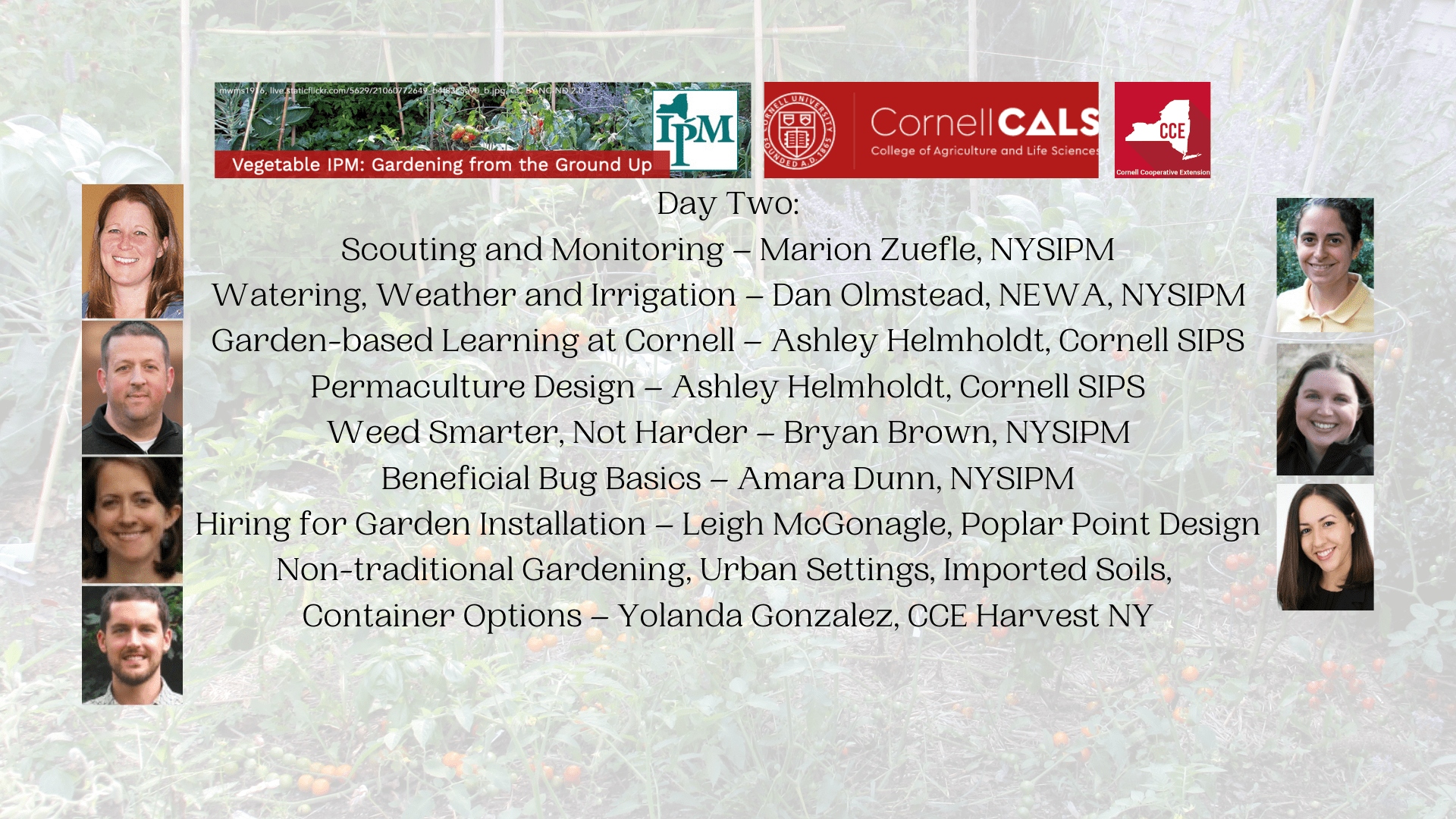A big thank you again to both our speakers and our attendees. You made this year’s virtual conference a huge success!

Here are some questions that came into the chat during the conference:
Pam W: Is using pesticide treated seeds considered organic?
Steve Reiners answers: Pesticide treated seeds would not be allowed in a certified organic farming operation.
~~
L.B.: Is it OK to remove the above ground parts of the plants at the end of the growing season but leave the roots in the soil over winter?
Steve Reiners: It’s fine to leave the roots in the soil and just remove the tops. Soil microbes will feed on the roots and break them down. Typically a foliar disease would not overwinter on the roots.
~~
Kristen: What is the best method of cleaning stakes and landscape fabrics?
Judy B: And cleaning metal cages?
Steve Reiners: Nice article here on the best way to clean garden stakes and cages
Connecticut IPM Program – Disinfecting Used Tomato Stakes (May 2013)
~~
Jennifer L: to Everyone: any resources for keeping carpenter bees controlled?
Elizabeth Lamb (provided these links):
Resource NYSIPM Get Rid of Carpenter Bees
NYSIPM Blog Post Get Rid of Carpenter Bees
~~
Linda – CCE Broome: I think a lot of people don’t understand what “direct sunlight” is.
From Elizabeth Lamb: In gardening, sunlight falling directly on the plant is direct sunlight, while indirect sunlight refers to shaded areas. Even that definition isn’t perfect
~~
Patti P: If you use straw for mulch, is there a depth that is sufficient? It seems as it gets deep it’s habitat for pests.
Steve Reiners: For straw mulch they recommend at least 4 inches for weed control. But you can use less by putting down a layer of paper first and then just enough straw to hold down the paper. A bale will go much further that way.
~~
Jill: To clean up or not clean up in the fall?
Abby Seaman : Maybe a compromise would be to be sure to remove any diseased plants and leave the rest.
Amara Dunn: I agree with Abby…clean up diseased (or insect-infested) plants in the fall (especially your vegetables). If you have dry stems from perennial (or annual) ornamentals (that weren’t diseased), leave those until spring.
~~
From Nancy J: Can you put (unidentified) eggs in a bag and watch what insect hatches to identify?
Elizabeth Lamb: Nancy, you can sometimes get the eggs to hatch if you can keep the leaf alive and not have the environment get too humid or hot.
From Marion Zuefle: Nancy, you could try but I have rarely had luck. The thing that has worked is to remove the leaves with the eggs and place them into water so the leaves don’t dry out.

Day One LINKS
From NYSIPM:
Updates and Map of Spotted Lanternfly
Visit the New York State Integrated Pest Management Program’s website
Visit the NYSIPM’s What’s Bugging You pages – in process and updated often!
NYSIPM Facebook page
The NYSIPM blog: Think IPM -when you get there, subscribe (little menu near the top) to receive a notification for any new blog post.
The NYSIPM YouTube page – So many great resources to watch or rewatch (like the 2021 Veg IPM Conference which will be available soon!)
More on Vegetable Gardening and General concerns for New Yorkers:
Links to Steve Reiners’ posts “Pandemic Vegetable Gardening” (and definitely not just for 2020!)
Penn State’s Give Square Foot Gardening a Try
Two resources on the invasive weed Lesser Celandine NY Invasive Species Lesser Celandine
And from Sharon Bachman, CCE Eries: Western New York PRISM lesser celandine
Soil: USDA Natural Resources Conservation Service – Unlock the Secrets of Soil
Compost Resources:
CCE Tompkins Compost Resources site
Cornell’s Waste Management Institute
Veg Growing Guides:
Cornell Vegetable Growing Guides:
Cornell Vegetable Varieties for Gardeners: (A Citizen Science program w/ log in)
Weed Pests
Cornell’s Weed ID Blog
Herbicide resistance in weed species
Cornell’s Vegetable MD online! Now with multiple options for Spanish-speaking gardeners!
Day Two LINKS:
Find the Cornell Cooperative Extension office near you
Vegetable Disease Resources:
The Cucurbit Downy Mildew Forecast homepage
Basil Ag Pest Monitor:
The National website tracking Late Blight: USABlight:
NEWA (NYSIPM)- the Network for Environmental and Weather Applications :
Microclimates in your yard (video from The Millennial Gardener)
Soil Quality: Penn State Intro to soil quality:
And for even more information https://extension.psu.edu/soil-quality-information
Cornell Master Gardener Program
Garden-based Learning: https://gardening.cals.cornell.edu/
Garden-based Learning -Troubleshooting pages
Gardening support from CCE Tompkins:
Pollinator support
Tick-talk
Food Gardening
Cornell Gardening: Exploring the Haudenosaunee Three Sisters Garden
NYSIPM Weeds –
Bryan Brown Weed Podcast “Into the Weeds”
NYSIPM Weed IPM page
Weed Viability Article from NPR
Effects of soil solarization Cornell SIPS Video
More on soil solarization
Top 3 Weeding Tips for Organic Gardens and Small Farms
Habitat for Beneficials:
A Pocket Guide to Common Natural Enemies (Oregon State)
Biocontrol Bytes Blog:
Creating habitat for beneficial insects around your home:
Finding plants that feed friendly insects:
When to clean up your garden in the spring
Compatibility: Pesticides and natural enemies of pests:
Harvest NY:
Rat Prevention: Training (Rat Academy):
Urban Soil Institute for soil lead testing: https://urbansoils.org/
Harlequin bug fact sheet
NYC Parks Green Thumb Program: GreenThumb Webinar Video Recordings:
LAST BUT NOT LEAST:
The New York State Integrated Pest Management Program’s HOME AND GARDEN GUIDES:
Chapter One Sneak Peek NYSIPM Home and Garden Guide: Introduction to IPM
Chapter Two Sneak Peek NYSIPM Home and Garden Guide: Garden Basics
Chapter Three Sneak Peek NYSIPM Home and Garden Guide: Your Flower Garden
Chapter Four Sneak Peek NYSIPM Home and Garden Guide: Vegetables (part one)
Chapter Four Sneak Peek NYSIPM Home and Garden Guide: Vegetables (part two)
